Abstract
The coat protein of bacteriophage MS-2 was cleaved with cyanogen bromide to yield three fragments, possessing the sequence 1-88 (P1), 89-108 (P2), and 109-129 (P3), respectively. The mixture of peptides P2 and P3, which could not be separated, was found capable of inhibiting the neutralization of the phage by antiserum to the whole MS-2. The peptides corresponding to P2 and P3 were therefore synthesized. The synthetic P3 had no capacity to interfere with neutralization of MS-2, not did its macromolecular conjugate with multichain poly(DL-alanine) elicit neutralizing antibodies. On the other hand, the synthetic P2 was very efficient in inhibiting the inactivation of the phage by the antiserum against phage. Furthermore, a synthetic antigen prepared by attachment of P2 to multichain poly(alanine) incuded antiserum in rabbits that was capable of neutralizing MS-2 activity almost as efficiently as the antiserum prepared against the intact coat protein. This inactivation is specific, because it can, in turn, be totally inhibited by P2 peptide.
Full text
PDF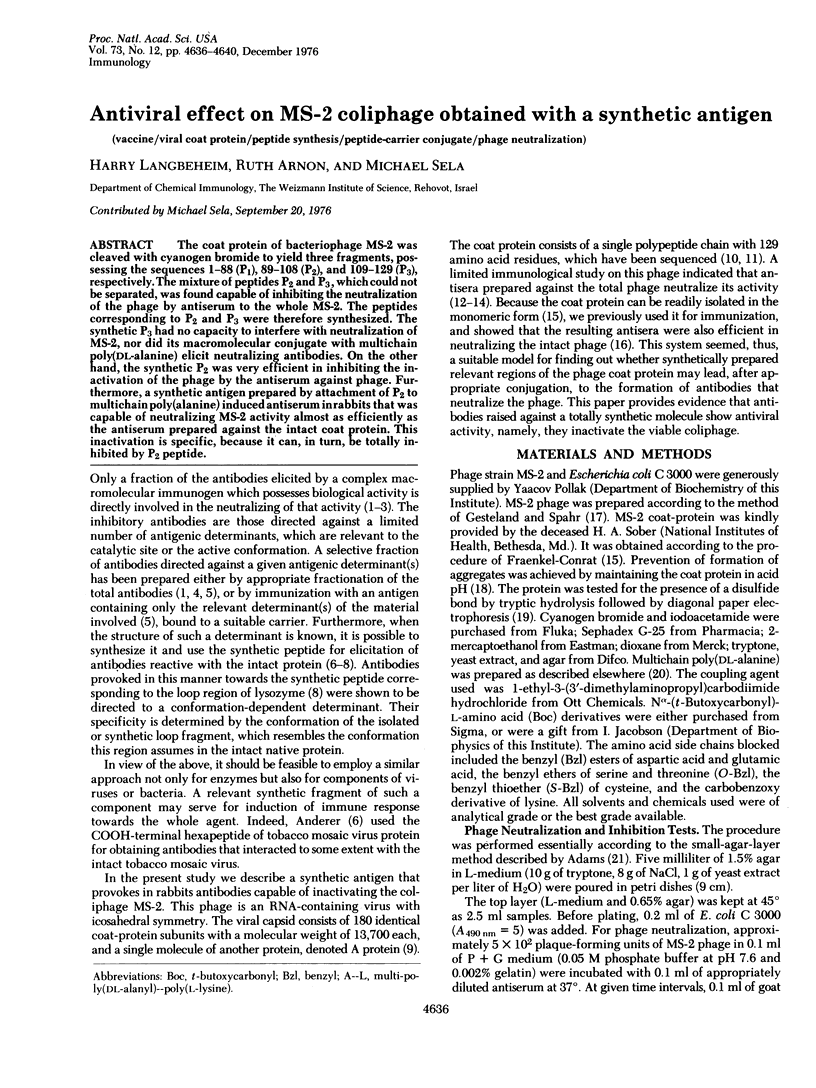
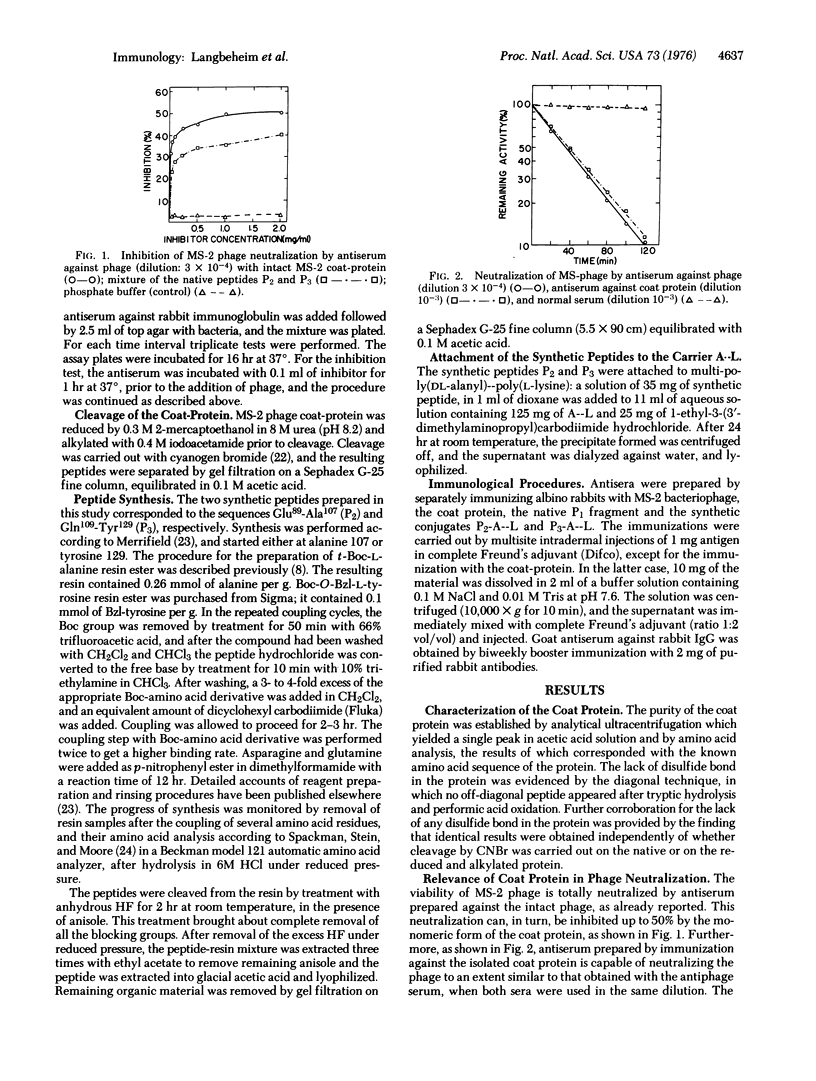
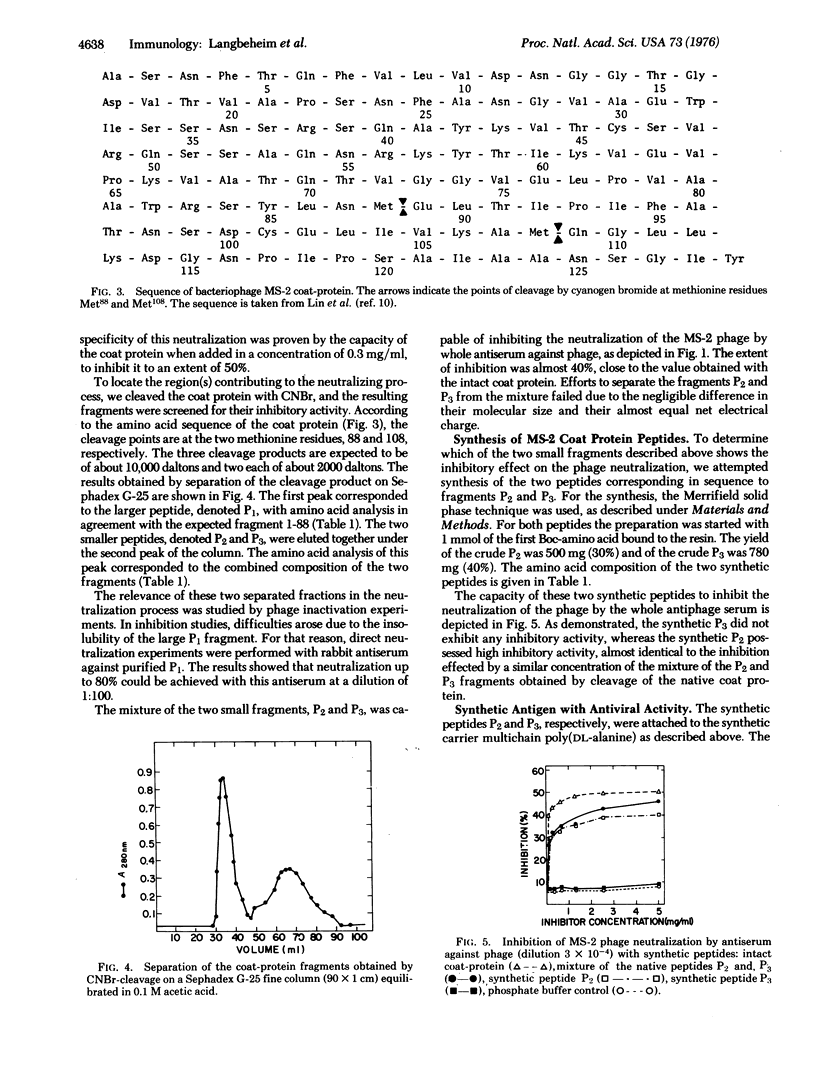
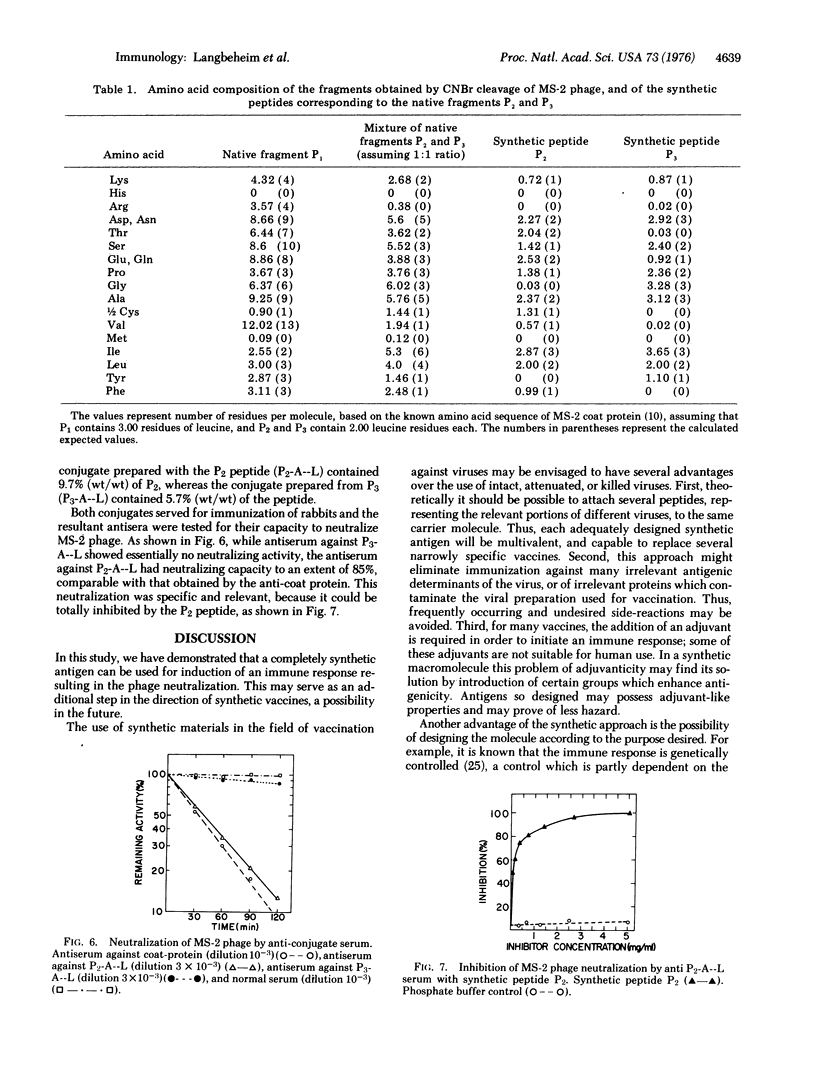
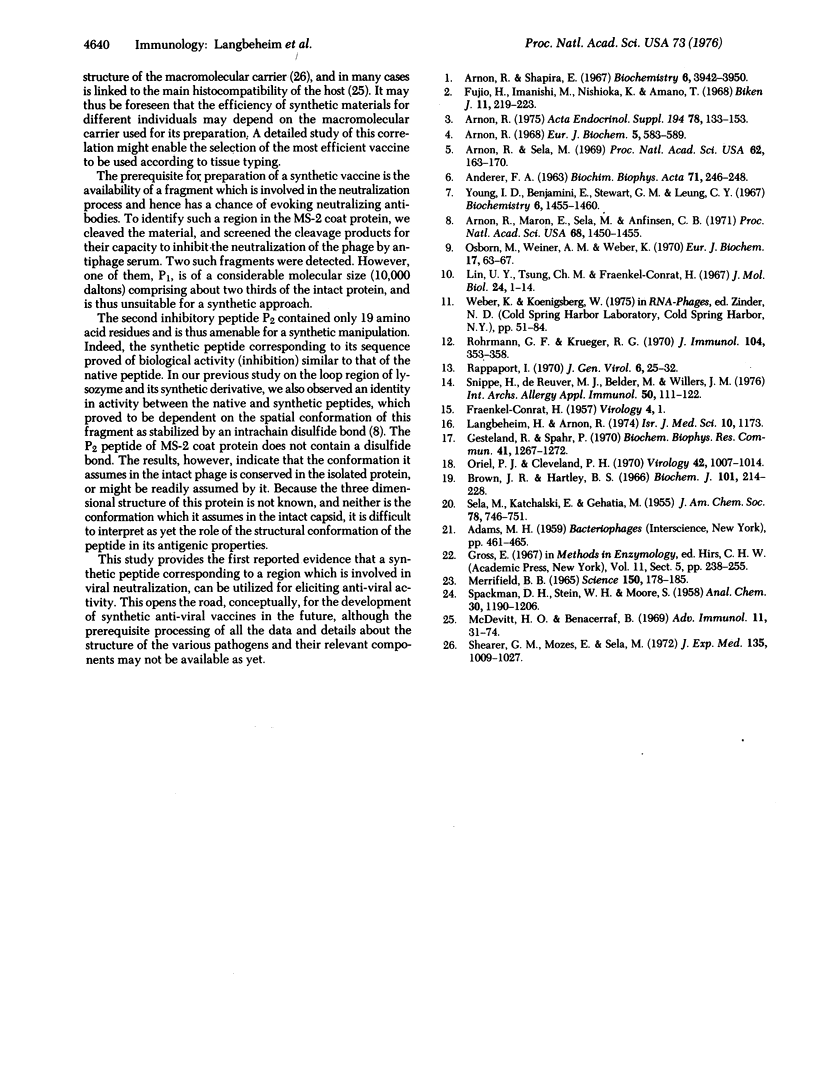
Selected References
These references are in PubMed. This may not be the complete list of references from this article.
- ANDERER F. A. Preparation and properties of an artificial antigen immunologically related to tobacco mosaic virus. Biochim Biophys Acta. 1963 Apr 2;71:246–248. doi: 10.1016/0006-3002(63)91077-1. [DOI] [PubMed] [Google Scholar]
- Arnon R. A selective fractionation of anti-lysozyme antibodies of different determinant specificities. Eur J Biochem. 1968 Sep 24;5(4):583–589. doi: 10.1111/j.1432-1033.1968.tb00409.x. [DOI] [PubMed] [Google Scholar]
- Arnon R. Enzyme inhibition by antibodies. Acta Endocrinol Suppl (Copenh) 1975;194:133–153. doi: 10.1530/acta.0.080s133. [DOI] [PubMed] [Google Scholar]
- Arnon R., Maron E., Sela M., Anfinsen C. B. Antibodies reactive with native lysozyme elicited by a completely synthetic antigen. Proc Natl Acad Sci U S A. 1971 Jul;68(7):1450–1455. doi: 10.1073/pnas.68.7.1450. [DOI] [PMC free article] [PubMed] [Google Scholar]
- Arnon R., Sela M. Antibodies to a unique region in lysozyme provoked by a synthetic antigen conjugate. Proc Natl Acad Sci U S A. 1969 Jan;62(1):163–170. doi: 10.1073/pnas.62.1.163. [DOI] [PMC free article] [PubMed] [Google Scholar]
- Arnon R., Shapira E. Antibodies to papain. A selective fractionation according to inhibitory capacity. Biochemistry. 1967 Dec;6(12):3942–3950. doi: 10.1021/bi00864a041. [DOI] [PubMed] [Google Scholar]
- Brown J. R., Hartley B. S. Location of disulphide bridges by diagonal paper electrophoresis. The disulphide bridges of bovine chymotrypsinogen A. Biochem J. 1966 Oct;101(1):214–228. doi: 10.1042/bj1010214. [DOI] [PMC free article] [PubMed] [Google Scholar]
- FRAENKEL-CONRAT H. Degradation of tobacco mosaic virus with acetic acid. Virology. 1957 Aug;4(1):1–4. doi: 10.1016/0042-6822(57)90038-7. [DOI] [PubMed] [Google Scholar]
- Fujio H., Imanishi M., Nishioka K., Amano T. Proof of independency of two antigenic sites in egg white lysozyme. Biken J. 1968 Sep;11(3):219–223. [PubMed] [Google Scholar]
- Gesteland R. F., Spahr P. F. A new procedure for the preparation of highly labeled intact 32P RNA from bacteriophage R-17. Biochem Biophys Res Commun. 1970 Dec 9;41(5):1267–1272. doi: 10.1016/0006-291x(70)90224-x. [DOI] [PubMed] [Google Scholar]
- McDevitt H. O., Benacerraf B. Genetic control of specific immune responses. Adv Immunol. 1969;11:31–74. doi: 10.1016/s0065-2776(08)60477-0. [DOI] [PubMed] [Google Scholar]
- Merrifield R. B. Automated synthesis of peptides. Science. 1965 Oct 8;150(3693):178–185. doi: 10.1126/science.150.3693.178. [DOI] [PubMed] [Google Scholar]
- Oriel P. J., Cleveland P. H. Reassembly of bacteriophage MS2 protein from 9 M urea. Virology. 1970 Dec;42(4):1007–1014. doi: 10.1016/0042-6822(70)90349-1. [DOI] [PubMed] [Google Scholar]
- Osborn M., Weiner A. M., Weber K. Large scale purification of A-protein from bacterior17. Eur J Biochem. 1970 Nov;17(1):63–67. doi: 10.1111/j.1432-1033.1970.tb01134.x. [DOI] [PubMed] [Google Scholar]
- Rappaport I. An analysis of the inactivation of MS2 bacteriophage with antiserum. J Gen Virol. 1970 Jan;6(1):25–32. doi: 10.1099/0022-1317-6-1-25. [DOI] [PubMed] [Google Scholar]
- Rohrmann G. F., Krueger R. G. Precipitation and neutralization of bacteriophage MS-2 by rabbit antibodies. J Immunol. 1970 Feb;104(2):353–358. [PubMed] [Google Scholar]
- Shearer G. M., Mozes E., Sela M. Contribution of different cell types to the genetic control of immune responses as a function of the chemical nature of the polymeric side chains (poly-L-prolyl and poly-DL-alanyl) of synthetic immunogens. J Exp Med. 1972 May 1;135(5):1009–1027. doi: 10.1084/jem.135.5.1009. [DOI] [PMC free article] [PubMed] [Google Scholar]
- Snippe H., de Reuver M. J., Belder M., Willers J. M. Bacteriophage MS-2 in the immune response. Int Arch Allergy Appl Immunol. 1976;50(1):111–122. doi: 10.1159/000231487. [DOI] [PubMed] [Google Scholar]
- Young J. D., Benjamini E., Stewart J. M., Leung C. Y. Immunochemical studies on tobacco mosaic virus protein. V. The solid-phase synthesis of peptides of an antigenically active decapeptide of tobacco mosaic virus protein and the reaction of these peptides with antibodies to the whole protein. Biochemistry. 1967 May;6(5):1455–1460. doi: 10.1021/bi00857a030. [DOI] [PubMed] [Google Scholar]


